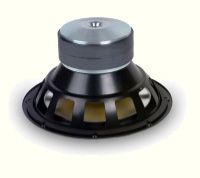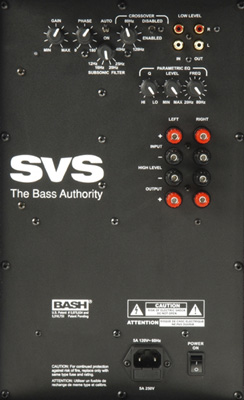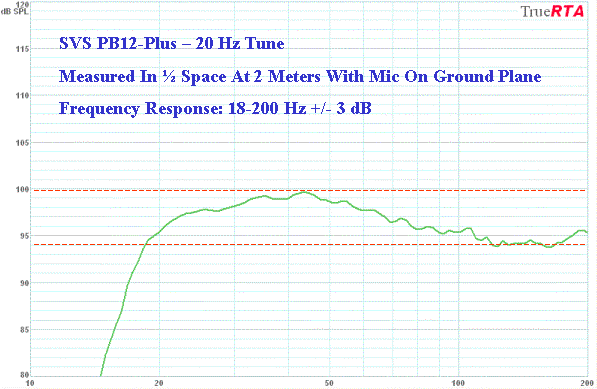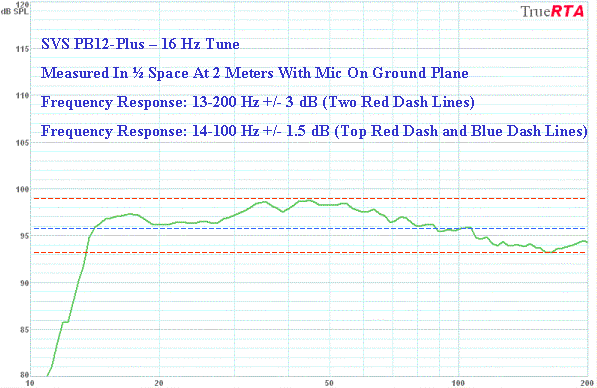Woofer Description
The woofer is manufactured by TC-Sounds exclusively for SVS, and was first
introduced in the PC-Plus powered cylinder line a few years ago. Referred to
as the dB12, this driver has undergone numerous upgrades since its
introduction, which SVS indicates have significantly improved its
performance and durability.
 The
latest iteration (dB12.2) of this driver has the following features:
The
latest iteration (dB12.2) of this driver has the following features:
- An overhung 2" voice coil with an aluminum former
- An extra deep stamped steel basket allowing for high excursion
- A double stacked strontium-ferrite magnet assembly
- A vented pole piece
- An aluminum cone with inverted dust cap and nitrile rubber surround
- Dual mirrored spiders with opposing tinsel leads for symmetrical centering
forces
Amplifier Description
- Digital BASH (Indigo) 525 watts continuous
- Phase Control (0-180 degrees continuously variable)
- Tune Settings (20, 16, 12 Hz – each with optimized EQ and high pass
filter)
- Single band PEQ (frequency, Q, attenuation; premium finishes only)
- Clipping, thermal, and overload protection limiters
- On/Auto (2-way toggle, red/green indicator light)
- Gain/Volume control
- Low Pass Filter with defeat switch (40 Hz -120 Hz, continuously variable, 2nd
order)
- Low Level L/R RCA inputs and outputs
- High level L/R inputs and outputs (fixed 100 Hz 1st order high pass
filter)
- Power switch (2-way rocker) with replaceable fuse
- Detachable Heavy Duty Power Cord (3 prong)
The control layout is logical, and all the switches and rotary controls move
smoothly with a quality feel. I liked the rubberized covering on the rotary
controls, which makes them easy to adjust.
The continuously variable 0-180 phase control allows precise phase
integration between the speakers and the subwoofer at the crossover
frequency. The phase control is also very useful for integrating multiple
subwoofers in a room.
The single band on-board PEQ features three continuously variable controls:
Bandwidth (Q = 0.1-0.9), Frequency (20 Hz -80 Hz), and Level (0 dB -12 dB
attenuation). Essentially, this control can be used to tame a peak in the
in-room frequency response. The owner's manual provides an in-depth
description of how to operate the PEQ. During my testing, I did notice the
attenuation control was somewhat non-linear, with most of the cut effect
occurring in the latter half of the control range.
On the Bench
Set-Up: All objective tests were conducted outside and away from any
reflective structures, with the subwoofer sitting on the ground plane. The
microphone was also placed on the ground plane, perpendicular to the
subwoofer at a distance of two meters from the width and depth center point of
the cabinet. This test environment (often called ½ space or 2 pi) will
provide a very similar (but not identical) frequency response as a free air
(full space or 4 pi) test environment.
Frequency Response Test
A subwoofer with a flat frequency response will
sound even and linear across the entire pass band. And the deeper a
subwoofer can extend, the better it will be able to play pipe organ music,
or the extremely deep special effects found on many action DVDs.
A short-duration (about 0.5 seconds) digitally synthesized logarithmic sine
sweep was used to evaluate the frequency response of the subwoofer. The
output of the sweep was adjusted to 95 dB -100 dB over the majority of the pass
band. The sweep resolution is 1/24 octave, with no smoothing applied.
In the 20 Hz tune, the PB12-Plus frequency response measured 18 Hz -200 Hz
± 3
dB, characterized by a peak in the 30 Hz -70 Hz region.

In the 16 Hz tune, the frequency response flattened considerably, measuring
13 Hz - 200 Hz ± 3 dB, and an excellent 14
Hz - 100 Hz ± 1.5 dB.

Click Here to Go to Part III.